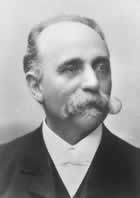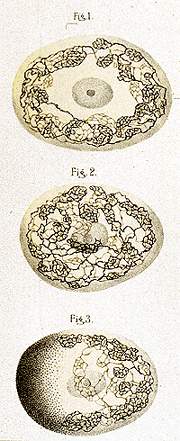Camillo Golgi discovers the Golgi Apparatus
 Who:Camillo Golgi
Who:Camillo GolgiWhen:July 15, 1898
Why: To further understanding of the central nervous system.
Methods: Golgi invented a method of staining by hardening nervous cells in potassium bichromate and then impregnating the sample with silver nitrate. The resultant reaction, known as the black reaction allowed him to see the Golgi apparatus under the microscope.
Institution: University of Pavia
Where: Pavia, Italy
Technology: Microscope, Staining Technique, Black Reaction
 |
| Camillo Golgi |
Camillo Golgi (1843-1926) was born in Pavia, Italy. He graduated from the University of Pavia Medical school at age 22, and went on to adopt a high interest in neurology.2 Golgi conducted neurological research at the University of Pavia till financial difficulties forced him to accept a position as Chief Medical Officer in a mental hospital.
 |
| Golgi's original sketch of the network he discovered. Courtesy of The Nobel Prize Website |
Determined to continue research, Golgi created a lab in a small kitchen. There, he developed his famous black reaction, a technique of staining neurological cells by encasing them in potassium bichromate and then impregnating them with silver nitrate. The technique deposited black outlines on cells in a random fashion, allowing for discovery of cell elements that were previously obscured by other staining techniques. Though the exact reason the technique works remains a mystery, it is so effective that the black reaction is still used today, and earned Golgi a Nobel Prize in Medicine.1
In 1898 Golgi announced to the Pavia Medical Society that he had discovered a delicate network inside cells which he termed "apparato reticolare interno" (internal reticular apparatus). The network was soon named the Golgi apparatus and is essential for both the transmission and reception of information between cells.
References
Links




